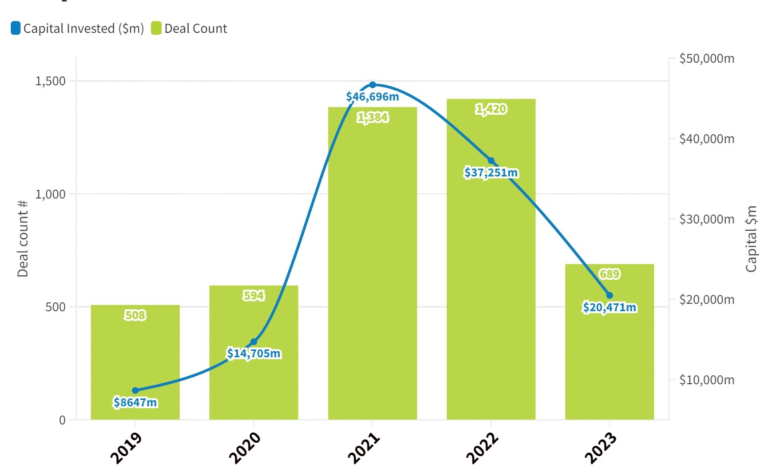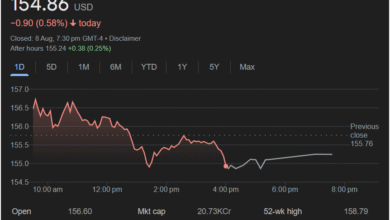Fintech Interest Rates: Challenges and Profits Explained

Fintech interest rates are at the heart of a transformative financial landscape where technology meets traditional banking. Recently, many fintech firms, including darlings like Robinhood and Revolut, thrived as rising interest rates bolstered their net interest income, significantly improving their profitability. However, as we enter a new economic phase marked by a decline in interest rates, these digital banks face a critical reckoning. The sustainability of fintech profitability, heavily reliant on this income boost, raises important questions about future strategies, particularly income diversification. As they contend with falling rates, fintechs must adapt by innovating their revenue streams or risk significant setbacks.
Within the realm of financial technology, the dynamic between interest rates and profitability is evolving rapidly. The concept of fintech—often synonymous with digital banking—is not just about providing online services but also about leveraging changing economic conditions to maximize revenue. As interest rates decline, companies within this space are finding new ways to enhance their income through diversified models beyond traditional interest streams. This challenges firms to rethink how they generate revenue, highlighting the importance of resilience in their business frameworks. Ultimately, the ongoing shifts in interest rates could serve as a litmus test for the effectiveness and adaptability of various fintech business models.
The Impact of Falling Interest Rates on Fintech Profitability
As interest rates begin to decline, fintech platforms are confronted with a pivotal challenge that could significantly affect their profitability. Companies like Robinhood, Revolut, and Monzo have reported robust gains attributed to higher interest rates, with many using these profits to bolster their positions in a competitive market. The increase in net interest income—defined as the difference between the interest earned on loans and the interest paid on deposits—has provided a cushion for these companies. However, with forecasts indicating a downward shift in interest rates, these firms must reevaluate their dependency on such income streams and consider the implications on their financial health.
The transition to a low-interest-rate environment tests the foundational business models of several fintechs. Should interest rates continue to decline, these firms could see a contraction in net interest income, necessitating a shift towards income diversification. As noted by Lindsey Naylor from Bain & Company, this period could expose vulnerabilities within the existing frameworks of many fintech firms. Flexible adjustments in their revenue generation strategies, such as focusing on fee-based offerings or innovative products, will be crucial to maintain a sustainable profit margin.
Digital Banks and the Quest for Income Diversification
Digital banks are increasingly aware that relying solely on interest income, particularly when facing declining interest rates, is a risky proposition. Innovators like Revolut are expanding their offerings beyond traditional banking services by incorporating trading platforms for cryptocurrencies and shares, aiming for a broader income portfolio. This approach not only enhances their revenue streams but also supports customer retention and engagement, essential elements in an evolving financial landscape. Diversifying into sectors that cater to customer interests allows these banks to thrive, even in less favorable interest rate conditions.
Moreover, fintech leaders like Bunq demonstrate the effectiveness of diversifying income sources. With a revenue model that encompasses subscriptions, card fees, and interest earnings, Bunq operates with a more robust financial safety net. CEO Ali Niknam’s insights reveal how a well-rounded income strategy can mitigate risks associated with a volatile interest rate environment. As digital banks seek longevity and resilience, the integration of diversified income sources will prove to be key in navigating potential downturns in net interest income.
Challenges Faced by Fintechs in Managing Interest Rate Changes
The recent decline in interest rates presents significant hurdles for fintech firms that have relied heavily on net interest income for their profitability. Companies like ClearBank have already reported pre-tax losses, illustrating the impact of shifting economic conditions on their operational strategies. The pressures of transitioning from interest income to fee-based services require fintechs to innovate and adapt swiftly. Mark Fairless, CEO of ClearBank, emphasizes the need for strategic planning that accounts for a potential decrease in interest income, which may necessitate a shift in the overall business approach, focusing more on fee generation rather than traditional interest earnings.
As fintechs grapple with these challenges, some may uncover opportunities for growth and improvement in their business models. By exploring innovative products and services that appeal to consumers, fintech firms can enhance their appeal and cultivate customer loyalty, which is vital in a shifting financial environment. In essence, while the current interest rate trends pose risks, they also compel fintechs to rethink their strategies, adapt to market demands, and focus on building a more resilient and diversified revenue generation framework.
Strategies for Fintechs to Thrive Amidst Interest Rate Decline
In response to the declining interest rates, fintech companies are employing various strategies to safeguard their profitability. A prime approach involves investment in technology and digital platforms that enhance customer engagement and streamline operations, ultimately driving down costs and improving revenue generation. Companies like Revolut, for instance, are augmenting their service offerings by providing additional functions such as mobile plans, thereby increasing their value proposition and catering to a broader audience. This not only bolsters their income diversification strategy but also solidifies their market presence in a competitive landscape.
Additionally, fintechs are pursuing strategic partnerships and collaborations to expand their reach and explore new revenue avenues. By integrating services such as insurance, investment options, and enhanced payment solutions, these firms can effectively diversify their income. Emphasizing a customer-centric approach that delivers tailored experiences will be essential in retaining and attracting users. Ultimately, fintechs that proactively adapt to the changing interest rate environment and prioritize innovation are more likely to sustain their growth and profitability in the long run.
The Role of Customer Engagement in Fintech Profitability
Customer engagement plays a critical role in ensuring the profitability and sustainability of fintech companies, particularly in times of fluctuating interest rates. Digital banks that actively cultivate strong relationships with their clients through personalized services stand a better chance of retaining them amidst economic uncertainties. Enhanced engagement strategies, such as offering educational resources and tailored financial advice, can significantly improve customer loyalty, ultimately driving higher retention rates and greater revenue generation in the long run.
Moreover, fintechs that prioritize customer feedback and adapt their offerings accordingly are more likely to succeed in identifying new income opportunities. The gathering of user data allows companies to create better-targeted products and services, fostering a sense of belonging and trust among users. A positive customer experience becomes invaluable as it directly correlates to financial success; in a landscape dictated by declining interest rates, maintaining customer engagement becomes a cornerstone of building long-term resilience and profitability for fintech firms.
Analyzing the Future of Fintech in a Low-Interest Environment
The future of fintech is poised for significant transformation as the industry grapples with the impending effects of sustained low interest rates. Traditional models that rely heavily on interest income will need to evolve, pushing fintech firms to explore innovative solutions and alternative revenue generation methods. Analysts like Lindsey Naylor suggest that the ability to adapt will determine which companies will thrive, as those with diversified income models may shield themselves from the potential fallout associated with an adverse interest rate environment.
In navigating this uncertain future, fintechs must remain vigilant, with a keen eye on market trends and customer preferences. The ability to pivot and introduce adaptable strategies will help mitigate risks associated with declining interest incomes, ensuring their relevance in a rapidly changing financial landscape. With proactive planning and a commitment to innovation, fintech firms can chart a path toward sustainable growth even in the face of challenging economic conditions.
The Importance of Financial Education in Fintech Services
Financial education is a critical component of successful fintech services, particularly in a fluctuating interest rate context. As fintech companies strive to diversify their revenue streams and reduce their dependence on interest income, educating customers about financial products and services becomes paramount. Companies that prioritize financial literacy initiatives not only empower their users to make informed decisions but also cultivate a loyal customer base that understands and appreciates the value of their offerings.
By integrating educational resources directly into their platforms, fintechs can help customers navigate complex financial landscapes, ultimately enhancing their engagement and trust. In times of economic instability, such as during a decline in interest rates, informed consumers are more likely to explore additional services or adjust their financial behaviors in ways that benefit both the consumer and the fintech. Therefore, by investing in financial education, fintechs can unlock new avenues for income diversification and establish a competitive advantage in the marketplace.
Peer Comparison: Fintech Success Amidst Interest Rate Fluctuations
In the fintech industry, understanding peer performance amidst interest rate fluctuations offers valuable insights into effective strategies for sustainability. Companies like Robinhood, which achieved a notable annual profit driven by a substantial increase in net interest income, serve as benchmarks for others navigating the same challenges. By studying the successes and shortcomings of peers, fintechs can identify best practices and pivot their business models accordingly to adapt to the evolving economic landscape.
Furthermore, a comparative analysis between firms showcases the varying approaches to income generation, particularly in how some have diversified their revenue sources more effectively than others. Digital banks that rely predominantly on card fees or interest income may find themselves at a disadvantage as rates decline. In contrast, fintechs that have embraced comprehensive revenue strategies are likely to weather the storm and continue thriving, establishing a competitive edge that is invaluable in the face of interest rate challenges.
Preparing for Regulatory Changes in Fintech
As fintech evolves amidst shifting interest rates, it is crucial for firms to remain prepared for potential regulatory changes that may arise. Government regulations surrounding interest rates, lending practices, and consumer protections can significantly influence how fintech companies operate. Staying informed and adaptable to these changes will be essential in sustaining profitability and ensuring compliance with legal frameworks. Fintechs that proactively engage with policymakers and understand emerging regulations will be better positioned to navigate the complexities of the financial landscape.
Additionally, embracing regulatory compliance can act as a competitive differentiator in the fintech sector. Firms that prioritize transparency and adhere to evolving regulations build trust among consumers, foster robust customer relationships, and enhance their reputations in the marketplace. Ultimately, adeptly preparing for regulatory changes—while also keeping a keen focus on the impacts of declining interest rates—will enable fintechs to sustain their operations and profitability in a dynamic economic environment.
Frequently Asked Questions
How do fintech interest rates impact profitability for digital banks?
Fintech interest rates play a crucial role in determining the profitability of digital banks by influencing their net interest income. As interest rates rise, fintechs can charge more for loans compared to what they pay on deposits, enhancing their overall profitability. Conversely, a decline in interest rates could pressure these banks to diversify their income streams to maintain profitability.
What challenges do fintechs face with the decline in fintech interest rates?
The decline in fintech interest rates poses significant challenges for fintech firms, particularly those heavily reliant on net interest income. Falling interest rates can lead to reduced earnings from loans, prompting these companies to seek alternative revenue sources, such as fee-based services, to sustain their business models and profitability.
How has the interest rate decline affected fintech firms like Robinhood and Revolut?
Fintech firms like Robinhood and Revolut, which initially benefited from high interest rates, are now grappling with the effects of an interest rate decline. Although they reported impressive net interest income in the past, the current low-rate environment requires them to adapt their strategies, potentially focusing on income diversification to secure long-term profitability.
What strategies are fintechs implementing to diversify income amidst declining interest rates?
In response to declining interest rates, many fintechs are adopting strategies for income diversification. This includes expanding into non-interest services such as cryptocurrency trading, fee-based products, and subscription models. Companies like Revolut and Bunq have successfully broadened their revenue streams to reduce dependence on traditional interest income.
How does income diversification affect the sustainability of fintech business models during interest rate declines?
Income diversification can significantly enhance the sustainability of fintech business models during interest rate declines. Fintechs that develop a robust mix of revenue sources, beyond just interest income, are better equipped to weather economic fluctuations, ensuring they remain viable even when traditional revenue streams are impacted by lower interest rates.
What is the relationship between fintech interest rates and net interest income?
Fintech interest rates directly influence net interest income, which is the difference between the interest a fintech earns on loans and the interest it pays to depositors. A higher interest rate typically increases net interest income, boosting profitability for fintechs. However, as rates decline, fintechs may see squeezed margins, emphasizing the need for strategic shifts in their business operations.
Why are some fintechs more resilient than others in a declining interest rate environment?
Fintechs that exhibit resilience in a declining interest rate environment often have well-diversified income streams, allowing them to offset reduced net interest income. Companies that capitalize on robust customer engagement through non-interest services or fee income are better positioned to adapt and thrive, demonstrating flexibility in their business models.
What insights can we draw from the performance of ClearBank regarding fintech interest rates?
ClearBank’s experience underlines the impact of declining fintech interest rates, as it reported a shift from reliance on interest income to more fee-based income due to lower rates. This indicates that fintech firms may need to reevaluate their income strategies to adapt to a changing financial landscape, focusing on alternative revenue streams for growth.
| Key Points | ||
|---|---|---|
| Fintech firms like Robinhood, Revolut, and Monzo benefitted from increasing interest rates in 2024, leading to higher profits. | Robinhood reported a profit of $1.4 billion, largely driven by a 19% increase in net interest income, totaling $1.1 billion. | Monzo achieved its first annual profit with a 167% increase in net interest income, while Revolut saw a 58% rise, reaching £1.1 billion ($1.45 billion). |
| The decline in interest rates raises concerns about the long-term sustainability of fintech profits reliant on net interest income. | Falling rates are viewed as a test of the resilience of fintech business models; some may struggle while others may adapt. | ClearBank cited a pre-tax loss due to shifting from interest income to fee-based income, emphasizing a strategic focus on fee growth. |
| Diversification of revenue streams is key for fintechs to withstand declining interest rates; those with non-interest services are better positioned. | Bunq, a Dutch neobank, reported a 65% profit increase, relying on subscriptions and fees rather than interest alone. | Neobanks focusing solely on interest from deposits may face significant income reductions if rates continue to fall. |
Summary
Fintech interest rates have significantly influenced the profitability and survival of many financial technology firms. As interest rates decline, these firms face crucial decisions regarding their business models, especially those heavily reliant on net interest income. The volatility in interest rates tests the adaptability of fintech players, highlighting the need for diversified income strategies to ensure long-term success and resilience in a fluctuating financial landscape.




